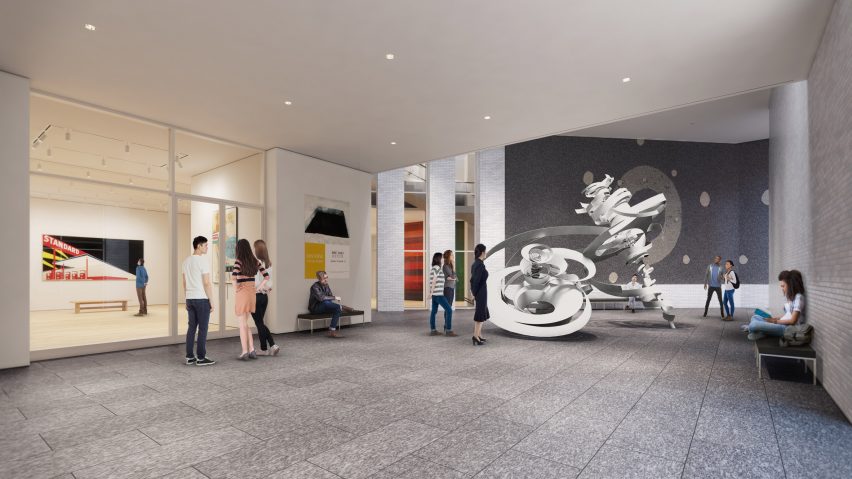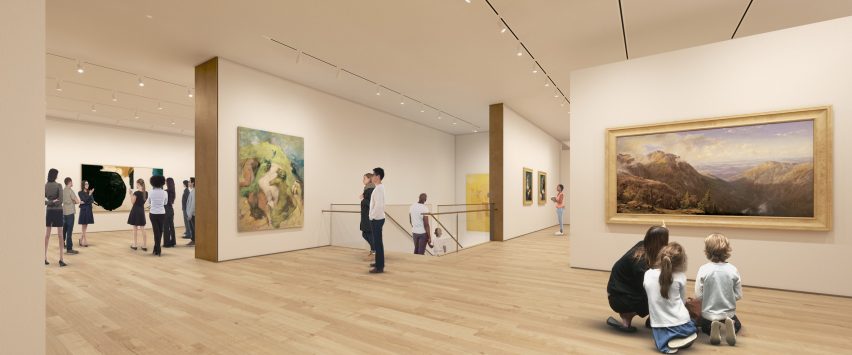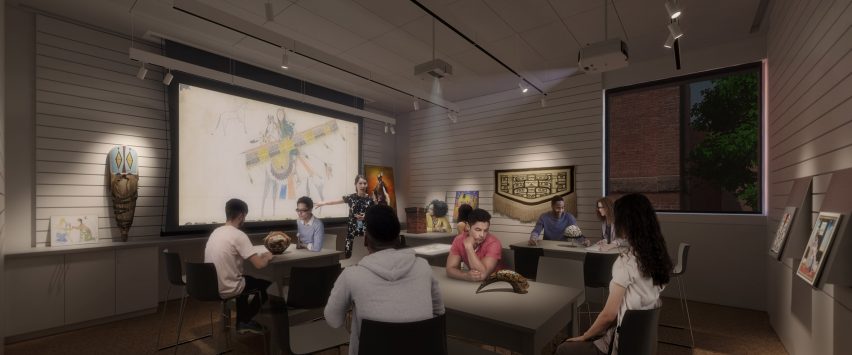Tod Williams and Billie Tsien’s major extension and renovation of postmodern architect Charles Moore’s Hood Museum of Art, in New Hampshire, will involve slotting in a pale brick building and covering a central courtyard.
Architects: Tod Williams Billie Tsien Architects
Location: United States
Currently under construction, the project will bring the institution to 16,350 square feet (1,518 square metres) – nearly 50 per cent larger than the existing building at Dartmouth College. The overhaul encompasses new galleries to showcase an extended art collection, and expanded teaching facilities.
Tod Williams Billie Tsien Architects will also reconfigure the layout of the red-brick building completed by Moore in 1985, which the husband-and-wife duo in charge of the New York firm described as being in a “tangle” before work commenced.

“It’s like we were given a ball of string that had a lot of knots inside,” Tsien told journalists during a presentation on 26 June 2018.
Project intended to improve campus views and circulation
Moore designed the Hood Museum of Art to fit between the campus’ 19th-century red-brick Wilson Hall and the modernist Hopkins Center for the Performing Arts, built by Wallace K Harrison in 1962.
Forming part of the college’s campus, Moore’s design curves around a central courtyard that Williams and Tsien will cover over to provide a flexible event space for meetings, dinners and performances.

A portion of the existing museum will be removed to open up views to the surroundings and offer two routes into the museum: one running east-west, and another north-south to link with Dartmouth’s green.
“There’s a new dynamic in terms of how people walk and move through the campus,” said Tsien. “Rather than it being primarily one way traffic, it now connects both north to the green and south to the arts plaza and town.”
Design takes “liberties” with Moore’s museum
The demolition will make way for a top-heavy structure, built in “off-white brick” to complement the rest of Dartmouth’s campus. Tsien and Williams intend to front the structure with an arched window, following the line of a feature that continues from the existing Moore building.
“We took the liberty of completing the arch,” said Williams during the press event. “There’s no question we’ve taken liberties with Moore’s work but we’ve respected the idea behind it.”
The project will see the rest of Moore’s building restored, with additions and changes intended to blend in with the existing.
Moore’s stairwell will be preserved and made visible from the enclosed courtyard, with the new covering offering enough shade to prevent the glare on the glass that hindered the view previously.
A second staircase will be added to form a continuous route through the building, leading from the Center for Object Study – comprising three teaching galleries – to 11 exhibition spaces of varying layouts on the second level.
For the interiors, the architects propose to create continuity between the six new galleries and the existing 10 with similar materials.
Overhaul faces controversy
Moore was described as “one of the most influential and prolific practitioners of postmodern design” in an obituary by the New York Times following his death aged 68 in 1993, and the Hood Museum is considered one of his most important projects.
Therefore, Williams and Tsien have faced criticism for the changes to Moore’s building as part of their $50 million (£38 million) overhaul.

But the duo argued that the project weaves with the original design, and urged critics to wait until its official opening on 26 January 2019 before passing judgement.
“It’s not so easily identifiable, it’s very knitted,” said Tsien. “I think it’s an important part of thinking about simply of objects all over the place, but a knitting together.”
Williams and Tsien “don’t care about the criticism”
Williams and Tsien, who established their firm in 1986, are best known for their 2001 American Folk Art Museum in New York, which was controversially demolished 13 years after it was built to make way for the expansion of neighbouring MoMA.
The duo has also encountered controversy with projects including the completed Barnes Foundation in Philadelphia, and the upcoming Obama Presidential Library, which will be built in Chicago’s historic Jackson Park.
“I don’t care about the criticism,” said Williams. “I believe we have to build what we believe in, which is absolutely holding onto Moore where we can, and enhancing it where we can and at the same time being authentic to ourselves.”
“We took huge criticism before the Barnes, we’ll take it on the Obama Presidential Center, trust me it’s where I want to be,” he continued. “We want to ride that line perfectly to absolutely respect the Moore work, to respect Dartmouth and respect it as it grows in the future.”





